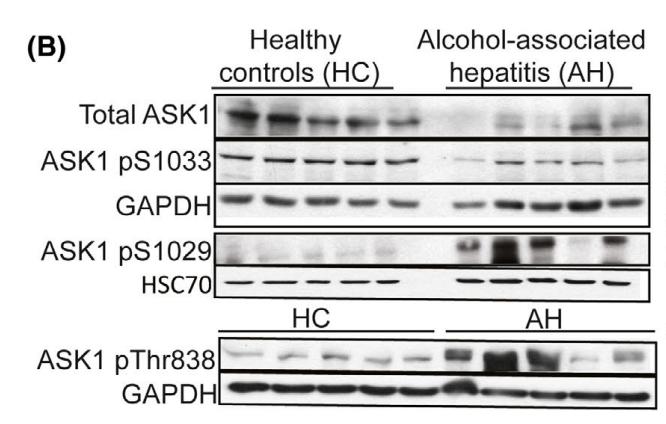| 产品: | 磷酸化 ASK1 (Ser1029) 抗体 |
| 货号: | AF3549 |
| 描述: | Rabbit polyclonal antibody to Phospho-ASK1 (Ser1029) |
| 应用: | WB |
| 文献验证: | WB |
| 反应: | Human, Mouse, Rat |
| 分子量: | 155kD(Calculated). |
| 蛋白号: | Q99683 |
| RRID: | AB_2846863 |
产品描述
*The optimal dilutions should be determined by the end user.
*Tips:
WB: 适用于变性蛋白样本的免疫印迹检测. IHC: 适用于组织样本的石蜡(IHC-p)或冰冻(IHC-f)切片样本的免疫组化/荧光检测. IF/ICC: 适用于细胞样本的荧光检测. ELISA(peptide): 适用于抗原肽的ELISA检测.
引用格式: Affinity Biosciences Cat# AF3549, RRID:AB_2846863.
展开/折叠
Apoptosis signal regulating kinase 1; Apoptosis signal-regulating kinase 1; ASK 1; ASK-1; ASK1; M3K5; M3K5_HUMAN; MAP/ERK kinase kinase 5; MAP3K5; MAPK/ERK kinase kinase 5; MAPKKK5; MEK kinase 5; MEKK 5; MEKK5; Mitogen activated protein kinase kinase kinase 5; Mitogen-activated protein kinase kinase kinase 5;
抗原和靶标
A synthesized peptide derived from human ASK1 around the phosphorylation site of Ser1029.
- Q99683 M3K5_HUMAN:
- Protein BLAST With
- NCBI/
- ExPASy/
- Uniprot
MSTEADEGITFSVPPFAPSGFCTIPEGGICRRGGAAAVGEGEEHQLPPPPPGSFWNVESAAAPGIGCPAATSSSSATRGRGSSVGGGSRRTTVAYVINEASQGQLVVAESEALQSLREACETVGATLETLHFGKLDFGETTVLDRFYNADIAVVEMSDAFRQPSLFYHLGVRESFSMANNIILYCDTNSDSLQSLKEIICQKNTMCTGNYTFVPYMITPHNKVYCCDSSFMKGLTELMQPNFELLLGPICLPLVDRFIQLLKVAQASSSQYFRESILNDIRKARNLYTGKELAAELARIRQRVDNIEVLTADIVINLLLSYRDIQDYDSIVKLVETLEKLPTFDLASHHHVKFHYAFALNRRNLPGDRAKALDIMIPMVQSEGQVASDMYCLVGRIYKDMFLDSNFTDTESRDHGASWFKKAFESEPTLQSGINYAVLLLAAGHQFESSFELRKVGVKLSSLLGKKGNLEKLQSYWEVGFFLGASVLANDHMRVIQASEKLFKLKTPAWYLKSIVETILIYKHFVKLTTEQPVAKQELVDFWMDFLVEATKTDVTVVRFPVLILEPTKIYQPSYLSINNEVEEKTISIWHVLPDDKKGIHEWNFSASSVRGVSISKFEERCCFLYVLHNSDDFQIYFCTELHCKKFFEMVNTITEEKGRSTEEGDCESDLLEYDYEYDENGDRVVLGKGTYGIVYAGRDLSNQVRIAIKEIPERDSRYSQPLHEEIALHKHLKHKNIVQYLGSFSENGFIKIFMEQVPGGSLSALLRSKWGPLKDNEQTIGFYTKQILEGLKYLHDNQIVHRDIKGDNVLINTYSGVLKISDFGTSKRLAGINPCTETFTGTLQYMAPEIIDKGPRGYGKAADIWSLGCTIIEMATGKPPFYELGEPQAAMFKVGMFKVHPEIPESMSAEAKAFILKCFEPDPDKRACANDLLVDEFLKVSSKKKKTQPKLSALSAGSNEYLRSISLPVPVLVEDTSSSSEYGSVSPDTELKVDPFSFKTRAKSCGERDVKGIRTLFLGIPDENFEDHSAPPSPEEKDSGFFMLRKDSERRATLHRILTEDQDKIVRNLMESLAQGAEEPKLKWEHITTLIASLREFVRSTDRKIIATTLSKLKLELDFDSHGISQVQVVLFGFQDAVNKVLRNHNIKPHWMFALDSIIRKAVQTAITILVPELRPHFSLASESDTADQEDLDVEDDHEEQPSNQTVRRPQAVIEDAVATSGVSTLSSTVSHDSQSAHRSLNVQLGRMKIETNRLLEELVRKEKELQALLHRAIEEKDQEIKHLKLKSQPIEIPELPVFHLNSSGTNTEDSELTDWLRVNGADEDTISRFLAEDYTLLDVLYYVTRDDLKCLRLRGGMLCTLWKAIIDFRNKQT
研究背景
Serine/threonine kinase which acts as an essential component of the MAP kinase signal transduction pathway. Plays an important role in the cascades of cellular responses evoked by changes in the environment. Mediates signaling for determination of cell fate such as differentiation and survival. Plays a crucial role in the apoptosis signal transduction pathway through mitochondria-dependent caspase activation. MAP3K5/ASK1 is required for the innate immune response, which is essential for host defense against a wide range of pathogens. Mediates signal transduction of various stressors like oxidative stress as well as by receptor-mediated inflammatory signals, such as the tumor necrosis factor (TNF) or lipopolysaccharide (LPS). Once activated, acts as an upstream activator of the MKK/JNK signal transduction cascade and the p38 MAPK signal transduction cascade through the phosphorylation and activation of several MAP kinase kinases like MAP2K4/SEK1, MAP2K3/MKK3, MAP2K6/MKK6 and MAP2K7/MKK7. These MAP2Ks in turn activate p38 MAPKs and c-jun N-terminal kinases (JNKs). Both p38 MAPK and JNKs control the transcription factors activator protein-1 (AP-1).
Phosphorylated at Thr-838 through autophosphorylation and by MAP3K6/ASK2 which leads to activation. Thr-838 is dephosphorylated by PPP5C. Ser-83 and Ser-1033 are inactivating phosphorylation sites, the former of which is phosphorylated by AKT1 and AKT2. Phosphorylated at Ser-966 which induces association of MAP3K5/ASK1 with the 14-3-3 family proteins and suppresses MAP3K5/ASK1 activity. Calcineurin (CN) dephosphorylates this site. Also dephosphorylated and activated by PGAM5.
Ubiquitinated. Tumor necrosis factor (TNF) induces TNFR2-dependent ubiquitination leading to proteasomal degradation.
Cytoplasm. Endoplasmic reticulum.
Note: Interaction with 14-3-3 proteins alters the distribution of MAP3K5/ASK1 and restricts it to the perinuclear endoplasmic reticulum region.
Abundantly expressed in heart and pancreas.
Belongs to the protein kinase superfamily. STE Ser/Thr protein kinase family. MAP kinase kinase kinase subfamily.
研究领域
· Cellular Processes > Cell growth and death > Apoptosis. (View pathway)
· Cellular Processes > Cellular community - eukaryotes > Tight junction. (View pathway)
· Environmental Information Processing > Signal transduction > MAPK signaling pathway. (View pathway)
· Environmental Information Processing > Signal transduction > Sphingolipid signaling pathway. (View pathway)
· Environmental Information Processing > Signal transduction > TNF signaling pathway. (View pathway)
· Genetic Information Processing > Folding, sorting and degradation > Protein processing in endoplasmic reticulum. (View pathway)
· Human Diseases > Drug resistance: Antineoplastic > Platinum drug resistance.
· Human Diseases > Endocrine and metabolic diseases > Non-alcoholic fatty liver disease (NAFLD).
· Human Diseases > Neurodegenerative diseases > Amyotrophic lateral sclerosis (ALS).
· Organismal Systems > Nervous system > Neurotrophin signaling pathway. (View pathway)
文献引用
Application: WB Species: Mice Sample: liver
限制条款
产品的规格、报价、验证数据请以官网为准,官网链接:www.affbiotech.com | www.affbiotech.cn(简体中文)| www.affbiotech.jp(日本語)产品的数据信息为Affinity所有,未经授权不得收集Affinity官网数据或资料用于商业用途,对抄袭产品数据的行为我们将保留诉诸法律的权利。
产品相关数据会因产品批次、产品检测情况随时调整,如您已订购该产品,请以订购时随货说明书为准,否则请以官网内容为准,官网内容有改动时恕不另行通知。
Affinity保证所销售产品均经过严格质量检测。如您购买的商品在规定时间内出现问题需要售后时,请您在Affinity官方渠道提交售后申请。产品仅供科学研究使用。不用于诊断和治疗。
产品未经授权不得转售。
Affinity Biosciences将不会对在使用我们的产品时可能发生的专利侵权或其他侵权行为负责。Affinity Biosciences, Affinity Biosciences标志和所有其他商标所有权归Affinity Biosciences LTD.
